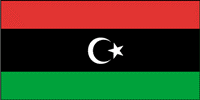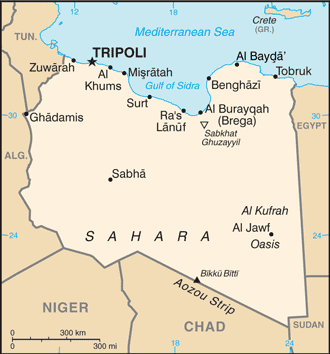Libya, with a total population of 5,613,380 as of July 2012, is located in Northern Africa, bordering the Mediterranean Sea, between Egypt and Tunisia. The country mostly has a mediterranean climate and covers a total area of 1,759,540 km2.
 |
The national flag of Libya.
Image Credits: CIA Factbook. |
Libya gained independence in 1951 and during the 1970s and 1980s, the government utilized oil funds to support terrorist and revolutionists in order to end capitalism and Marxism. The development of a Transitional National Council (TNC) in 2011 aimed at overthrowing the government and promoting democracy in Libya along with the development of a new government.
The country’s economic growth depends a lot on the production of hydrocarbons that make up 95% of the country’s exports. In 2006, Libya’s oil and gas sectors pulled in a lot of foreign investments and in 2011 the country’s GDP was $37.97 billion.
Overview of Resources
Libya’s key natural resources include natural gas, petroleum and gypsum. In 2010, the country produced high levels of hydrocarbons and the output of crude oil amounted to about 1.7 Mbbl/d.
In 2010, Libya was globally ranked 7th on the size of its crude oil reserves and was the fourth largest African country based on its crude oil output.
Other than crude oil, the country also produced lime, cement, sulfur, nitrogen, direct-reduced iron (DRI) and refined petroleum products in 2010.
Industrial Minerals
In 2009, Libyan Norwegian Fertilizer Co. operated urea and ammonia plants at Marsa El Brega, located east of Tripoli. Natural gas for these plants was supplied by NOC. These plants together were capable of producing 750 t/d of granular urea and 2,200 Mt/day of liquid ammonia.
In 2010, Libyan Norwegian Fertilizer Co. produced 900,000 t of urea and 700,000 t of ammonia. About 11% of ammonia and 93% of urea were exported by this company in 2010.
Metals
In 2010, Lisco was the country’s only iron and steel producer. The company produced 1.3 million Mt of direct-reduced iron in 2010 which was an increase in comparison with 2009’s direct-reduced iron output of 1.1 Mt.
Explorations for mineral resources that took place in Jabal Arkenu in southeastern Libya highlighted traces of iron-bearing quartzite, banded-iron and anomalous gold. Traces of marble were found at the Al Uwaynat area located in the Al Kufrah basin.

The map of Libya. Image Credits: CIA Factbook
Fossil Fuels
Libya’s natural gas and crude oil output and production of petrochemical and petroleum products increased in 2010 in comparison with that of 2009. In 2010, China was Libya’s chief petroleum importer and most of the country’s petroleum exports were sent to Europe.
In 2010, Libya had 2,064 crude oil producing wells and one natural gas reserve. In the same year, the country experienced a decrease in its number of petroleum wells that amounted to 200 in comparison with 247 wells in 2009.
The Sirte Basin in the northeast of Libya contained almost 80% of the country’s crude oil reserves. The amount of natural gas produced in the country in 2010 totaled to about 30.6 billion m3 and the country also had 1.5 trillion m3 of natural gas reserves.
Investment
In 2011, Libya’s mineral industry had to pause its operation including the production and export of crude oil because of the “February 17th Revolution” that led to a number of protests in Libya’s neighboring countries. This also resulted in the evacuation of expatriate employees by foreign companies in Libya. The country’s future largely depends on the establishment of a stable and permanent government.
Libya’s new government in 2011 focused on increasing the country’s production of hydrocarbons that contributes a lot in improving the economic growth rate. The mineral industry on the other hand hopes to improve its infrastructure and attract more investments to expand the country’s metal, industrial and hydrocarbon sectors.
The recent development in the mineral industry is the Sudanese-Libyan joint venture that aims at developing a joint mining project by carrying out exploration activities in the Mountain of Uweinat located at the borders of Sudan and Libya. Through such mining projects, the country hopes to increase its production and export of minerals and metals that will likely uplift the country’s economic status in the coming years.
Disclaimer: The Author of this article does not imply any investment recommendation and some content is speculative in nature. The Author is not affiliated in any way with any companies mentioned and all statistical information is publically available.
Sources and Further Reading